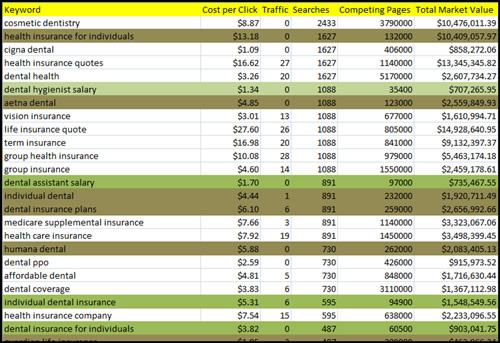If you spend as much time analyzing the SERPs (search engine result pages) as we do for the purpose of proactive SEO planning, you are bound to catch patterns or ranking anomalies which can provide insight into Google’s constantly evolving search engine algorithm.
If a few or few dozen of your keywords got clipped since May, here are three distinct flavors to the algorithm that we have noticed since the MayDay Update which slashed significant portions of mid-tail and long-tail traffic from e commerce sites (with similar on page characteristics) that lacked sufficient off page support.
Think of it like quality score meets organic search and those holding the short end of the stick “riding on fumes” got kicked back a few notches as the love-affair with broad match “3 word or more long-tail queries”.
First up:
1) The Close Cousin Keyword / Synonym Voucher:
- Web pages that ranked for one keyword variation appear to get a free pass to the top 10 and encroach on the root phrase with minimal effort.
- I.e. web pages that ranked for “keyword” company or “keyword” services are now interchangeable and can also rank for “root keyword” like a type of ranking credit or voucher based on a tweak to the weighting mechanism of term weights, links and relevance.
2) Deep Links are Rewarded: Pages with Deep Links Have More Prominence than Less Relevant Authority sites.
For example, you are more likely to see a page that has deep links ranking for a keyword or key phrase (since that page has more relevance) than the previous broad match “catch all page” which was occupying the space because of the sites authority. This appears to reward deep links and exact match URL’s vs. domains who have attracted genuine link diversity to act as peers for relevance/validation.
3) Excessive Internal links are more likely to cause a penalty: Although this is still in the testing and observation phase, note that sites like Wikipedia who have a 94% deep link ratio has recently toned down their internal link ratios to 5% of the previous.
For example, pages that had (1) multiple anchors from the same page to a secondary target page and (2) internal links from EVERY contextual occurrence of a keyword have now been minimized to 1 occurrence out of 50 to apparently not tip the internal link relevance scale of repetitive anchor text.
What does this mean to you? If you have excessive noise from links from the same anchors, now may be the time to pull things back a bit or mix up the occurrences or keyword variations a bit. For example, instead of going site wide via footer links, sidebars or server side includes, try the first 10-20 occurrences of a link to a landing page for contextual purposes – then see how that fares before adding additional weight from internal links.
To summarize our observations:
- Pages with prominence can rank across a broader array of modifiers as a result of trust/merit.
- Pages with deep links targeting exact match title, url and meta have increased significance vs. sites with broad match connotations.
- Minimize excessive internal links to avoid tripping over optimization penalties.
In closing, the more unique content that distinguishes a page the better and as search algorithms are constantly tweaked to asses and dismiss noise or static on the website templates, server side includes, stale or lackluster meta data should be avoided like the plague after the Mayday Update.
In essence, strive to make each page unique, get at least 5 links to the page to create citation and peer review via deep links and make sure it has 10 internal links (but go easy on going too far with it) in order to appease the more sensitive collective algorithm which can mix, mash and parse data quicker and easier than ever to assess relevance after the Mayday Update aftermath.











Excellent site, keep up the good work. I read a lot of blogs on a daily basis and for the most part, people lack substance but, I just wanted to make a quick comment to say I’m glad I found your blog. Thanks
Really nice to know all the names of days Google changed the algorithm.
I keep reading and reading your articles, and to be honest is the few sources I keep getting on my Reader after deleting dozens of other SEO unuseful sites.
Thanks Odena:
We try to keep it real here. Glad you enjoy the posts…